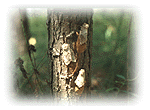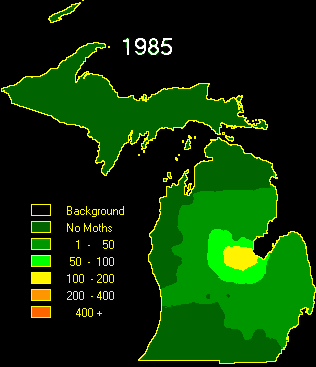
 |
Gypsy Moth Dynamics in Michigan |
| Stuart H. Gage |
The gypsy moth is an exotic organism imported into Massassachusites for the purpose of developing a silk industry after the Civil War. The insect escaped form confinement and began to spread across the North American continent. It reached Michigan in the early 1950's but was supposedly erradicated using pesticides. The gypsy moth reappeared locally in outgreak population levels near the Saginaw Bay in the late 1970's. After the USDA declared the insect a local issue, a monitoing program was established in 1985. Dramatic outbreaks and subsequent defoliation of forested lands in norther Michigan's less populated regions made this pest a major concern to Michigan residents. By 1988, when the LTER was established in southwestern Michigan, low numbers of gypsy moth were present in Kalamazoo County. The gypsy moth population has continued to expand in the southern Michigan and high populations in parks, residences and along lakeshores make this an important urban pest.
Developing an understanding of the growth and spread rate of a population of exotic organisms in a complex landscape is fundamental to potential management of introduced species. The objective of the project is to characterize the statewide annual trend in population change by mapping the distribution of moth catch throughout Michigan. This is intended to provide an early warning system to the residents of the state through education about population change and to assist with policy development regarding management of exotic species.
A network of 3,000 pheromone baited traps located at georeferenced permanent sites provide a methodology for measuring annual change in gypsy moth distribution in Michigan. Moth catch abundance has been determined at each of the permanent sites since 1985, thus providing a temporal geographic perspective of change in gypsy moth abundance and distribution. Because measurement of abundance has occurred at these permanent sites, our ability to measure rates of change at each location in response to weather or habitat type over the past 11 years has been possible.
Gypsy moth trends in Michigan have followed surprisingly regular and rapid patterns of change over the past 11 years. The center of the outbreak occurred west of the Saginaw Bay in Midland County. The population spread from that location northward into the extensive succeptible forests of the northern lower penninsula of Michigan. The southward spread of the gypsy moth has been slower due to discontinuous susceptible habitats. The spread in the Upper Penninsula has been regular but likely impeded by a harsh climate and the disconuous distribution of susceptible resources.
The following gypsy moth sequence is based on county mean trap catch from 3000 pheromone traps set at fixed locations on a 6 km grid spacing. The sequence is an 11 year period from 1985-1995,

The statewide gypsy moth project was concieved and designed by Stuart Gage in collaboration with the late Gary Simmons and other faculty at Michigan State University. A PhD student (Brad Parks), two international Visiting Scholars from China (Li Dianmo, Yang Dongshen), a Visiting Assistant Professor (Bryan Pijanowski) and technical specialists (Tim Wirth, Karlis Kaugars, Amos Zeigler) have participated in the study over the past 11 years. Bob Gardner and Bob Coulson have provided intellectual encouragement and modeling support. The staff of the Michigan Departments of Agriculrture and Natural Resources have played a significant role in the monitoring and defoliation assessment. John Helly at the San Diego Superomputer Center provided facilities for visualization of bpopulation trends.
Pijanowski, B.C, S.H. Gage and D.G. McCullough. 1995. Policy issues as they relate to the impacts of the gypsy moth in Michigan. Policy Options for the Michigan Legislature: 1994. Inst. for Public Policy and Social Research. Michigan State University Press, East Lansing,
Scriber, M.J. and S.H. Gage. 1995. Pollution and global change: plant ecotones, butterfly hybrid zones and changes in biodiversity. [In] Swallowtail Butterflies: Their Ecology & Evolutionary Biology.[Ed.] Scriber et al. Sci. Publ. Inc., Gainsville, FL. 459 pp.
Top | KBS Regionalzation | KBS LTER home page | The LTER network
For information contact: gages@pilot.msu.edu
Document author(s): Stuart Gage
E-Mail: gages@pilot.msu.edu
Revised: December 09, 1996
URL: http://www.ent.msu.edu/esal/lter_region